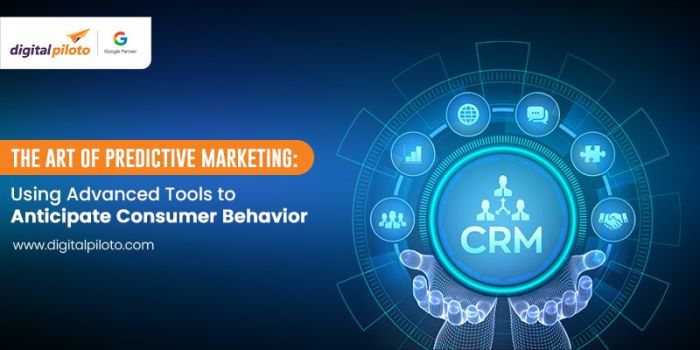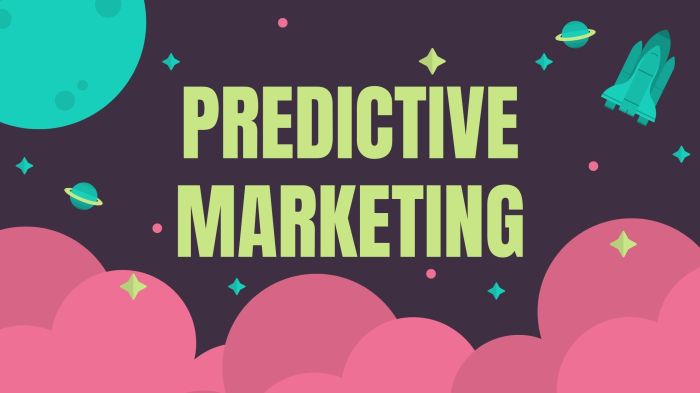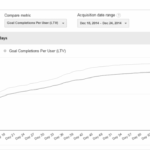Exploring predictive ais marketing potential – Exploring predictive AI’s marketing potential opens exciting possibilities for businesses to better understand and connect with their customers. From precise targeting to personalized experiences, predictive AI promises to revolutionize marketing strategies. This deep dive will explore the core concepts, data sources, applications, and potential benefits of incorporating predictive AI into marketing campaigns.
We’ll examine how predictive models can analyze vast datasets to anticipate customer behavior, optimize campaigns, and ultimately boost ROI. This exploration includes a look at data sources, segmentation strategies, personalized experiences, and campaign optimization techniques. We’ll also address the challenges and ethical considerations involved in using predictive AI in marketing.
Introduction to Predictive AI in Marketing
Predictive AI is revolutionizing marketing by enabling businesses to anticipate customer behavior and tailor their strategies accordingly. It goes beyond simply analyzing past data; it uses sophisticated algorithms to forecast future trends and potential outcomes. This allows marketers to make data-driven decisions, optimize campaigns, and ultimately achieve better results.Predictive AI models in marketing leverage statistical techniques to identify patterns and relationships within vast datasets.
These models are trained on historical data to learn how different variables influence customer behavior. The insights gleaned from these models can be used to predict future customer actions, such as purchasing decisions, brand loyalty, or churn.
Core Principles of Predictive AI Models
Predictive AI models in marketing rely on several key principles. These models identify patterns and correlations within data to predict future customer behavior. Machine learning algorithms are trained on historical data to establish these relationships. The models then use these learned patterns to forecast future customer actions, such as purchases or brand engagement. Accuracy of these predictions depends on the quality and quantity of data used for training.
Data Used to Train Predictive AI Models
A variety of data sources are used to train predictive AI models. These sources include customer demographics, purchase history, website interactions, browsing behavior, social media activity, and even publicly available data like economic indicators. The more comprehensive and relevant the data, the more accurate the predictions. Combining diverse data types, such as transactional and behavioral data, creates a richer understanding of customer behavior.
Applications of Predictive AI in Marketing Campaigns
Predictive AI can be implemented in various ways to enhance marketing campaigns. It can be used for customer segmentation, enabling targeted advertising campaigns that resonate with specific customer groups. Predictive models can also personalize customer experiences by recommending products or services based on individual preferences and needs. Predictive AI can optimize pricing strategies by forecasting demand and adjusting prices dynamically.
Furthermore, it can help in identifying potential customer churn and proactively engaging at-risk customers.
Potential Benefits of Predictive AI in Marketing
| Improved Customer Targeting | Personalized Experiences | Increased Conversion Rates | Reduced Marketing Costs | |
|---|---|---|---|---|
| Description | Predictive AI allows for the identification of ideal customer profiles, leading to more effective targeting. | By anticipating customer needs, AI personalizes the customer journey. | Accurate predictions improve the effectiveness of campaigns, leading to more conversions. | By optimizing resource allocation, AI minimizes wasted efforts and reduces costs. |
| Example | Identifying customers likely to purchase a specific product based on past behavior. | Recommending products based on browsing history and purchase patterns. | Predicting which customers are most likely to convert and tailoring messaging accordingly. | Automating campaign optimization and reducing manual adjustments. |
Exploring Data Sources for Predictive Models
Predictive AI in marketing relies heavily on the quality and variety of data used to train the models. Choosing the right data sources, understanding their limitations, and meticulously preparing the data are crucial steps in building accurate and effective predictive models. The insights gleaned from these models can significantly impact campaign performance, customer segmentation, and overall marketing ROI.Effective marketing strategies often hinge on understanding customer behavior and preferences.
By leveraging predictive AI models, businesses can anticipate future trends, personalize campaigns, and optimize resource allocation. This requires careful consideration of the diverse data sources available and the meticulous preparation needed to ensure model accuracy and reliability.
Data Sources for Predictive AI Models, Exploring predictive ais marketing potential
A wide array of data sources can be leveraged to train predictive AI models for marketing. These sources range from readily available social media interactions to detailed information within CRM systems. Each data source offers unique insights but also presents its own challenges.
Collecting, Cleaning, and Preparing Data
Data collection is the first step in building predictive models. Gathering data from various sources, such as website analytics, CRM systems, and social media, often involves using APIs or custom-built scripts. The collected data needs meticulous cleaning and preparation to ensure its quality and suitability for the model. This involves handling missing values, outliers, and inconsistencies. Data transformation techniques, like normalization or standardization, may be necessary to improve model performance.
Ethical Considerations
Data privacy and security are paramount in the realm of predictive AI. Companies must adhere to strict data protection regulations, like GDPR, to ensure compliance. Transparency about data usage and the purpose of predictive models is essential for building trust with customers. Models should be regularly audited to identify and mitigate any potential biases that might arise from the data used.
Data Quality and Model Accuracy
Data quality directly impacts the accuracy and reliability of predictive AI models. Inaccurate or incomplete data can lead to flawed predictions, misdirected marketing efforts, and ultimately, a loss of return on investment. Ensuring data quality involves thorough validation, data cleansing, and consistent data entry practices. Regular monitoring of data quality is critical to maintaining model accuracy.
Comparison of Data Sources
| Data Source | Strengths | Weaknesses |
|---|---|---|
| Social Media | Real-time insights into customer sentiment, preferences, and engagement; broad reach; relatively inexpensive | Potential for bias in data representation; difficulty in verifying data authenticity; data may not always be structured; data privacy concerns. |
| Website Analytics | Detailed information on user behavior, website interactions, and conversion rates; highly structured data; direct measurement of website performance | Limited understanding of customer characteristics beyond website interactions; data may not reflect overall customer preferences or behaviours outside of website interactions; privacy issues regarding user tracking. |
| CRM Systems | Comprehensive customer profiles, purchase history, and interactions with the company; highly structured and organized data; detailed customer segmentation | Data may be incomplete or inconsistent; data silos may exist, limiting insights from different customer touchpoints; potentially high cost of implementation and maintenance. |
| Market Research | Provides insights into market trends, competitor activities, and customer preferences; helps to identify opportunities and threats; often includes qualitative data | Costly; data collection may be time-consuming; may not reflect real-time market dynamics; sample size may limit generalizability. |
Predictive AI for Customer Segmentation and Targeting: Exploring Predictive Ais Marketing Potential
Predictive AI is rapidly transforming marketing strategies, moving beyond basic demographics to understand customer behavior and preferences. This deeper understanding allows businesses to tailor their marketing efforts to specific customer segments, increasing campaign effectiveness and ROI. This approach goes beyond broad targeting, recognizing that individual customers have unique needs and desires.By leveraging predictive models, businesses can identify high-value customers, personalize their experiences, and predict future behaviors.
This proactive approach allows companies to anticipate customer needs and respond effectively, leading to stronger customer relationships and increased revenue.
Customer Segmentation Strategies
Understanding your customer base is crucial for effective marketing. Predictive AI enables a more sophisticated approach to customer segmentation, moving beyond basic demographics to encompass behavioral patterns and predicted future actions. This allows for more precise targeting and more effective campaigns.
- Behavioral Segmentation: Predictive models analyze purchase history, website activity, engagement with marketing materials, and other interactions to categorize customers into groups based on their actions. For instance, a company might identify frequent online shoppers, infrequent purchasers, or customers who abandon their shopping carts. This allows for tailored marketing campaigns based on observed behaviors. Customers who abandon their carts, for example, might receive targeted emails offering incentives to complete their purchase.
Similarly, frequent buyers could be rewarded with exclusive offers or early access to new products.
- Preference Segmentation: Predictive AI models can analyze customer interactions, reviews, and feedback to understand their preferences. This analysis can identify groups of customers who share similar interests, needs, and values. A company selling clothing might segment customers based on their preferences for certain styles, colors, or brands. This allows for the development of highly targeted marketing campaigns showcasing products aligned with specific customer preferences.
- Value Segmentation: Predictive models can estimate the lifetime value (LTV) of each customer, helping businesses prioritize high-value customers. Factors considered might include purchase frequency, average order value, and customer tenure. High-value customers could receive personalized VIP treatment, including exclusive discounts and early access to new products. Understanding customer lifetime value is critical for resource allocation and maximizing return on investment in marketing efforts.
Identifying and Targeting Specific Customer Segments
Once customer segments are defined, the process of identifying and targeting them becomes critical. Predictive models can pinpoint the characteristics of each segment, enabling targeted marketing strategies.This involves using the identified segment criteria to develop targeted messaging and campaigns. For example, a segment of customers who frequently purchase organic products might receive targeted ads highlighting the health benefits of organic foods.
This precision allows for greater impact and reduced wasted resources on campaigns that don’t resonate with specific customer segments.
Digging into the potential of predictive AI in marketing is fascinating. But to make the most of these advanced tools, understanding tried-and-true marketing strategies for small businesses, like those detailed in proven marketing strategies to boost small businesses , is crucial. Ultimately, integrating these proven methods with predictive AI can unlock truly impressive growth opportunities for any business looking to leverage the power of data.
Tailoring Marketing Messages and Campaigns
Effective marketing involves crafting compelling messages that resonate with specific customer segments. This personalized approach leads to higher engagement and conversion rates.Tailoring messages involves creating content that addresses the unique needs and preferences of each segment. Using the previous example of organic food purchasers, the marketing message might highlight the environmental benefits of organic products, the superior taste, or the health advantages for families.
Example Segmentation Strategies
| Segmentation Criteria | Model Used | Targeted Actions | Expected Outcomes |
|---|---|---|---|
| Purchase history, website behavior | Regression, classification | Personalized product recommendations, targeted email campaigns | Increased conversion rates, higher customer lifetime value |
| Customer reviews, social media engagement | Natural Language Processing (NLP) | Tailored product suggestions, feedback collection | Improved customer satisfaction, enhanced brand reputation |
| Predicted customer churn | Survival analysis, time series | Proactive retention campaigns, personalized loyalty programs | Reduced customer churn, increased customer retention |
Predictive AI for Personalized Marketing Experiences
Predictive AI is revolutionizing marketing by moving beyond generic campaigns to crafting highly personalized experiences for individual customers. By analyzing vast amounts of data, AI algorithms can anticipate customer needs and preferences, enabling businesses to deliver targeted messages and offers at the right time and through the right channels. This targeted approach significantly increases engagement and conversion rates, while fostering stronger customer relationships.Leveraging predictive models allows businesses to understand the intricate nuances of customer behavior.
This knowledge can be translated into tailored product recommendations, customized content, and personalized communication strategies, ultimately enhancing the overall customer journey. This data-driven approach empowers businesses to anticipate customer needs, thereby driving significant value in their marketing efforts.
Personalization Strategies Powered by Predictive AI
Predictive AI enables marketers to go beyond simple demographics and delve into intricate customer profiles. This deeper understanding allows for the creation of highly personalized marketing strategies that resonate with individual customers. Instead of generic email blasts, AI-powered systems can deliver customized content tailored to specific customer interests, purchase history, and browsing behavior. This level of personalization significantly enhances engagement and fosters stronger customer relationships.
Examples of Personalized Marketing Strategies
Numerous examples demonstrate the effectiveness of predictive AI in personalized marketing. For instance, e-commerce platforms use AI to recommend products based on past purchases and browsing history. Streaming services leverage AI to suggest movies and shows based on viewing patterns and preferences. Financial institutions utilize AI to offer tailored financial advice and investment strategies. These examples illustrate how predictive AI can transform marketing from a broad, generic approach to a deeply personal and engaging experience.
Role of AI in Recommending Products and Services
AI plays a pivotal role in recommending products and services by analyzing customer data to identify patterns and predict preferences. Algorithms sift through vast datasets to identify products or services that align with individual customer profiles. This personalized recommendation engine significantly improves customer satisfaction by presenting relevant options. For instance, a customer who frequently buys outdoor gear might receive recommendations for hiking boots, tents, or camping equipment.
This tailored approach increases the likelihood of a purchase and builds customer loyalty.
Maintaining Data Privacy and User Control
Data privacy and user control are paramount in personalized marketing experiences. Businesses must implement robust security measures to protect sensitive customer data and adhere to stringent data privacy regulations. Transparent data policies and clear communication about data usage are crucial to build trust and maintain customer confidence. Providing users with control over their data, including the ability to opt out of personalized recommendations, is essential.
Steps in Creating a Personalized Marketing Campaign
Creating a personalized marketing campaign using predictive AI requires a structured approach. A well-defined process ensures the effectiveness and efficiency of the campaign.
- Data Collection and Preparation: Gather relevant data from various sources, including website interactions, purchase history, and customer surveys. Clean and prepare the data for analysis by addressing missing values and inconsistencies.
- Model Development and Training: Develop predictive models based on the prepared data to identify patterns and predict customer behavior. Train the models using appropriate algorithms and techniques. The goal is to create models that accurately predict customer behavior.
- Personalization Strategy Design: Design a personalized marketing strategy based on the predictions from the models. This strategy should Artikel how the insights from the models will be used to tailor marketing messages and offers to individual customers.
- Implementation and Testing: Implement the personalized marketing strategy across different channels, such as email, social media, and in-app notifications. Continuously test and refine the strategy based on performance metrics.
- Monitoring and Evaluation: Monitor the effectiveness of the campaign by tracking key performance indicators (KPIs). Regularly evaluate the results and adjust the strategy to optimize performance.
Predictive AI for Campaign Optimization and Performance Analysis

Predictive AI isn’t just about understanding past customer behavior; it’s about proactively shaping future marketing strategies. By leveraging predictive models, businesses can anticipate campaign performance, adjust tactics in real-time, and ultimately achieve better results. This allows for more efficient allocation of resources and a higher return on marketing investments.Predictive AI empowers marketers to move beyond reactive strategies and embrace a proactive approach to campaign optimization.
Diving into the potential of predictive AI in marketing is fascinating. Understanding how search algorithms work is key, and articles like ” inside the world of google how seo and ai shape search ” reveal how SEO and AI are shaping Google’s search results. This insight helps us appreciate the intricate dance between user queries and the AI-powered responses, ultimately offering a clearer picture of how to leverage predictive AI to optimize marketing strategies.
It provides the insights needed to anticipate campaign success or failure, allowing for adjustments before significant deviations occur. This agility is crucial in today’s fast-paced marketing landscape, where staying ahead of the curve is paramount.
Optimizing Marketing Campaigns
Predictive models can identify key factors influencing campaign performance, such as customer demographics, purchase history, and engagement patterns. This understanding enables the tailoring of messaging, channels, and timing for maximum impact. For example, a model might predict that a specific customer segment will respond better to a particular ad creative. This allows the marketer to allocate more budget and resources to that tailored approach, increasing the chances of a positive outcome.
Forecasting Campaign Performance
Predictive models can forecast campaign performance by analyzing historical data and identifying trends. This enables proactive adjustments to campaign strategies before performance significantly deviates from the expected trajectory. For instance, if a model predicts a lower-than-expected click-through rate for a particular campaign, marketers can adjust the ad copy, targeting parameters, or budget allocation to counteract the decline. This allows for real-time adaptation, which is crucial for maintaining campaign effectiveness.
A/B Testing and Predictive AI
A/B testing plays a critical role in refining predictive AI models. By testing different campaign variations, marketers can gather data to validate or adjust predictive models. For example, a predictive model might suggest a specific email subject line. A/B testing that subject line against other options will provide real-world feedback, helping to refine the model for future campaigns.
This iterative process of testing and refining the model ensures accuracy and adaptability.
Performance Metrics for Evaluation
Using predictive AI requires a structured approach to evaluating campaign success. A robust set of performance metrics is crucial for measuring the effectiveness of AI-driven strategies.
| Metric | Description | Importance |
|---|---|---|
| Conversion Rate | The percentage of users who complete a desired action (e.g., making a purchase). | A core metric indicating campaign effectiveness. |
| Customer Lifetime Value (CLTV) | The predicted revenue a customer will generate throughout their relationship with the company. | Indicates the long-term value of a campaign’s conversions. |
| Return on Investment (ROI) | The gain or loss generated on an investment relative to the cost of the investment. | Crucial for assessing the financial viability of marketing campaigns. |
| Customer Acquisition Cost (CAC) | The cost incurred to acquire a new customer. | Helps to understand the efficiency of customer acquisition strategies, which is often impacted by AI-powered optimizations. |
| Engagement Rate | The frequency and level of interaction customers have with campaign content. | Provides insights into the effectiveness of content and messaging. |
Challenges and Limitations of Predictive AI in Marketing

Predictive AI offers exciting possibilities for enhancing marketing strategies, but it’s crucial to acknowledge the inherent limitations and challenges. Blindly relying on AI without a deep understanding of its limitations can lead to ineffective campaigns and even detrimental consequences. This section delves into the potential pitfalls of predictive AI, emphasizing the importance of responsible implementation.Predictive AI models, while powerful, are not infallible.
They are only as good as the data they are trained on, and if that data contains biases or inaccuracies, the model’s predictions will reflect those flaws. Further, the complexity of human behavior and market dynamics can make it challenging to create models that consistently and accurately predict future outcomes.
Data Bias and Model Accuracy
Data used to train predictive AI models can reflect existing societal biases. If a dataset predominantly represents a specific demographic, the model might develop skewed perceptions of other groups, leading to inaccurate or discriminatory targeting. For example, if a model trained on historical purchasing data disproportionately represents affluent customers, it might overlook the needs and preferences of lower-income demographics, leading to missed opportunities and a narrow view of the market.
This underscores the importance of diverse and representative datasets to avoid perpetuating or amplifying existing inequalities.
Integration Challenges
Integrating predictive AI into existing marketing processes can be complex. Data silos, incompatible systems, and a lack of skilled personnel can hinder the smooth implementation of AI-powered tools. Existing marketing teams may require extensive training and upskilling to effectively utilize AI-driven insights. Additionally, the need to integrate data from various sources and formats can pose significant technical hurdles.
Maintaining data quality and security throughout the process is also critical.
Over-reliance and the Risk of Dehumanization
Over-reliance on predictive AI models can lead to a dehumanizing effect in marketing. Focusing solely on predicted outcomes might neglect the nuances of human interaction and the importance of personal connection. For example, a campaign that targets customers exclusively based on AI predictions without understanding their motivations and emotions could fall flat or even alienate them. Ultimately, marketing is about connecting with people on a human level, and AI should augment, not replace, that crucial element.
I’ve been digging into the potential of predictive AI in marketing, and it’s fascinating. One key area where this technology could be incredibly impactful is boosting repeat customer rates on Amazon. Understanding customer behavior through predictive AI could help tailor product recommendations and promotions, leading to higher customer satisfaction and ultimately more repeat purchases. Learning how to gain repeat customers on Amazon is crucial for success how to gain repeat customers on amazon , and AI can play a significant role in achieving that.
This deeper understanding of customer preferences will be vital in refining future marketing strategies.
Importance of Human Oversight and Ethical Considerations
“Predictive AI in marketing should be viewed as a tool to augment human judgment, not replace it entirely. Ethical considerations must guide the development and application of these technologies.”
Ethical considerations are paramount when implementing predictive AI in marketing. The potential for discrimination, privacy violations, and manipulation requires stringent oversight and clear ethical guidelines. Transparency in how models are trained and used, along with mechanisms for accountability and redress, is essential. Ultimately, the use of predictive AI in marketing should be guided by a strong ethical compass, ensuring fairness, respect, and the well-being of all stakeholders.
Future Trends and Implications of Predictive AI
Predictive AI is rapidly transforming the marketing landscape, moving beyond simple campaign optimization to encompass a deeper understanding of customer behavior and needs. This evolution promises to redefine how businesses interact with their target audiences, but also necessitates a reevaluation of marketing roles and responsibilities. The future of marketing hinges on the intelligent application of predictive analytics, demanding a proactive approach from marketers to adapt and thrive in this data-driven environment.The future of predictive AI in marketing is characterized by increasingly sophisticated algorithms, fueled by vast datasets and a greater emphasis on personalization.
This means marketing strategies will shift from broad-stroke campaigns to hyper-personalized experiences tailored to individual customer needs and preferences. AI-powered insights will not only predict future customer behavior but also proactively adapt marketing efforts to optimize outcomes in real-time.
Emerging Trends in Predictive AI for Marketing
Predictive AI is evolving beyond basic forecasting, moving towards proactive strategies that anticipate and respond to customer needs. This includes using AI to personalize product recommendations, anticipate customer churn, and even predict the success of marketing campaigns before they launch. These advancements are being driven by the continuous growth of data sources, making AI more accurate and adaptable.
Sophisticated algorithms are constantly being refined, allowing for more precise predictions and real-time adjustments to marketing campaigns.
Impact of Predictive AI on the Future of Marketing
Predictive AI will fundamentally reshape the future of marketing, shifting from a reactive to a proactive approach. Marketers will need to adapt to the changing role, leveraging AI tools to identify opportunities, segment customers more effectively, and deliver highly personalized experiences. This shift demands a greater emphasis on data analysis, algorithm interpretation, and continuous learning. Businesses will need to invest in data infrastructure and skilled personnel to maximize the potential of predictive AI.
Impact of Predictive AI on Marketing Jobs and Roles
The integration of predictive AI into marketing will inevitably impact existing job roles. While some tasks may become automated, new roles will emerge focused on data analysis, AI model management, and interpreting AI-generated insights. Marketing professionals will need to transition from executing campaigns to strategizing and optimizing AI-driven campaigns. This evolution will demand upskilling and reskilling to ensure marketers remain valuable contributors in the future of marketing.
Evolving Role of Human Marketers in a Predictive AI-Driven World
Human marketers will play a crucial role in the future, acting as strategists and interpreters of AI-generated insights. Instead of executing tasks, human marketers will focus on understanding the “why” behind AI predictions, crafting narratives that resonate with customers, and ensuring ethical considerations are addressed. They will be responsible for setting the overall marketing vision, defining the target audience, and interpreting the data in the context of business goals.
Comparison of Predictive AI’s Impact on Marketing Functions
| Marketing Function | Potential Impact of Predictive AI |
|---|---|
| Content Creation | AI can analyze audience preferences to suggest relevant content topics, optimize content formats, and even generate basic content formats. Human marketers will focus on crafting compelling narratives and ensuring the content aligns with the overall brand message. |
| Social Media Marketing | AI can identify trending topics, optimize social media ad targeting, and automate social media engagement. Human marketers will focus on developing engaging content strategies, fostering brand communities, and monitoring brand reputation. |
| Customer Service | AI can proactively identify potential customer issues, provide personalized support, and automate routine inquiries. Human marketers will focus on handling complex customer issues, building long-term customer relationships, and maintaining a high level of customer satisfaction. |
Wrap-Up
In conclusion, exploring predictive AI’s marketing potential unveils a powerful toolkit for businesses to enhance customer engagement and achieve higher marketing ROI. By understanding the intricacies of predictive models, data sources, and segmentation strategies, marketers can harness the power of AI to create personalized experiences and optimize campaigns. However, it’s crucial to acknowledge the challenges and limitations, ensuring ethical considerations and human oversight are integral to successful implementation.






